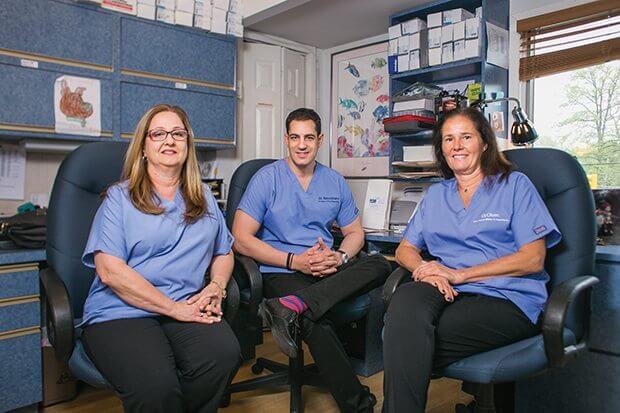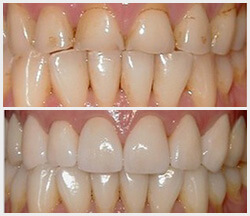Find Relief for TMJ Symptoms Without Surgery
Temporomandibular joint disorder (TMD) affects the jaw joint and muscles that control jaw movement. While some cases of TMD require surgery, there are many non-surgical TMD treatment options available that can help relieve pain and improve function.
Our Staten Island dentists offer effective non-surgical TMD treatment options. Learn more and how you may benefit.
Benefits of Non-Surgical TMD Treatment Options
While there are surgical options for treating TMD, non-surgical options are often preferred due to lower risk and faster recovery time. Some benefits of non-surgical TMD treatment include:
- Lower risk of complications
- Faster recovery time
- More conservative approach
- Improved quality of life
- Cost-effective
Non-Surgical TMD Treatment Options
Physical Therapy
Physical therapy is an effective non-surgical TMD treatment option that can help improve jaw mobility, relieve pain, and reduce muscle tension. A physical therapist can work with you to develop an individualized treatment plan that may include exercises to strengthen and stretch your jaw muscles.
Medications
Medications are also a non-surgical TMD treatment option. Over-the-counter pain relievers, such as ibuprofen or acetaminophen, can help relieve pain and inflammation, while muscle relaxants can help reduce muscle tension. In some cases, your dentist may also recommend prescription medications such as tricyclic antidepressants or anti-anxiety drugs to help manage pain and muscle spasms.
Botox Injections
Botox is a neurotoxin that can temporarily paralyze muscles, which can help reduce muscle tension. Botox works by blocking the signals sent from the nerves to the muscles, which causes the muscles to relax and become less tense. While repeat injections may be necessary, they offer several benefits as a non-invasive, quick, and customizable treatment option.
Restorative Dental Work for TMD
Restorative dental work may also be used to treat TMD. Those treatments include:
- Dental Crowns: Dental crowns repair or replace damaged or missing teeth. They fit over the existing tooth or implant, improving the alignment of the bite and reducing pressure on the jaw joint and muscles.
- Dental Bridges: Dental bridges replace one or more missing teeth. They’re anchored to the surrounding teeth or implants, improving the alignment of the bite and reducing pressure on the jaw joint and muscles.
- Dental Implants: Dental implants replace missing teeth down to the roots. They’re implanted into the jawbone, improving the alignment of the bite and reducing pressure on the jaw joint and muscles.
The type of restorative dental work recommended for TMD treatment will depend on the specific needs of the individual patient. Your dentist will evaluate your condition and recommend the most appropriate solution for your needs.
Oral Appliances for TMD
Several types of oral appliances and splints can be used for non-surgical TMD treatment:
- Night Guards: Customized mouth guards worn while you sleep can prevent teeth grinding (bruxism), which contributes to TMJ symptoms and jaw pain.
- Bite Splints: Teeth grinding or clenching puts excessive pressure on the jaw joint and muscles. Bite splints are worn over the upper or lower teeth to redistribute biting and chewing forces. They’re made of hard acrylic, soft plastic, or a combination of the two.
- Stabilization Splints: These splints are similar to bite splints but stabilize the jaw joint in a specific position. They’re often recommended for patients with more severe TMD symptoms, as they can help reduce muscle tension and improve jaw alignment.
- Anterior Positioning Appliances: These devices move the lower jaw forward, which can help relieve pressure on the jaw joint and muscles. Positioning appliances can help patients with a receding lower jaw or other structural abnormalities that contribute to TMD symptoms.
Frequently Asked Questions
Are there any side effects of non-surgical TMD treatments?
As with any treatment, non-surgical solutions may come with certain side effects. Side effects vary depending on the type of treatment, but non-surgical options carry a lower risk of complications compared to surgical options. Patients should discuss potential side effects with their healthcare provider before undergoing treatment.
Can non-surgical TMD treatments prevent the need for surgery?
It depends on the severity of your condition. Non-surgical TMD treatments are often effective in treating the condition and may prevent the need for surgery. However, surgery may be necessary for severe or persistent cases of TMD.
Are non-surgical TMD treatments covered by insurance?
Non-surgical TMD treatments may be covered by insurance, but coverage varies depending on the treatment and insurance plan. Be sure to contact your provider beforehand for more information.
Are Botox injections a safe option for treating TMD?
Yes! Botox works by blocking the signals sent from the nerves to the muscles, which causes the muscles to relax and become less tense. When Botox gets injected into the muscles that control the jaw joint, it can help reduce muscle tension and alleviate pain and discomfort associated with TMD.
Non-Surgical and Non-Invasive TMJ Symptom Relief
Non-surgical TMD treatment options can effectively alleviate pain and discomfort. Don’t wait any longer to seek relief from your TMD symptoms Contact our Staten Island dentists to learn how we can provide non-invasive treatment to get you back to living without jaw pain.



Insurance
We accept many insurances. Please contact one of our Insurance Coordinators to discuss your dental coverage plan.
(718) 948 5111
appointments@sidental.com
Open 7 days a week
Reviews
The dentists are absolutely excellent…
“I have been going here for years. The dentists are absolutely excellent and they always have an appointment available that fits into a busy schedule. I also completed invisilgn and my teeth are perfectly straight now. They also practice preventive medicine and just went in for my 6 month cleaning. Every time feel like I have a new set of choppers and best yet the check up noted no cavities!.”
— J.R
Pleasant visit
“As usual, it was a pleasant visit thanks to Dr. Nasso and her great staff..”
— C.M.
Always treated with courtesy and respect.
“Always treated with courtesy and respect. All of my questions were answered regarding upcoming treatments..”
— J.C.
Smile Profile




Put your best face forward.
Create a positive change to your teeth and your smile.
